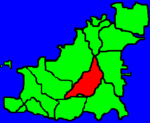|
Parish of St Andrew
St. Andrew is located in the centre of Guernsey. It is hilly and landlocked, with lovely fields and valleys with green views. The parish includes land that is occupied by the airport, the eastern side of Footes Lane and the Grammar School. "St Andre de la Pommeraye" is how the parish is traditionally referred to. The parish church, St Andrew of the Apple Orchard, is one of Guernsey's smallest churches. It is believed to have reached its present size by the 15th century. It is located opposite a spring, La Fontaine de St. Clair, whose waters were said to possess healing powers. The church name proclaims the fact that this was one of the island's cider-making centres. In the 19th century over 10% of the land in the parish was covered by orchards. The shortage of pubs in the parish could be attributed to the amount of cider around. The Last Post, situated between the Little Chapel and the German Underground Hospital, is as near to a country pub as you can get in Guernsey. Built in the lane known as La Vassalerie, the German Underground Hospital covers 75,000 square feet and has one and a quarter miles of corridors. The tunnels were built as shelters for troops and the hospital was only used for about six weeks. Guernsey Military Underground Hospital is privately owned but open to the public. The Little Chapel, inextricably linked with the building that towers above it, Les Vauxbelets (translates pretty little valley) is decorated by sea shells and broken china. A granite stone in Bullion Road, St Andrew's dates as far back as 1783 and is belived to have been laid as a central marker point for Guernsey before the reclamation of the Braye du Valle. Other famous landmarks within the parish are The Princess Elizabeth Hospital (also known as the PEH) and the Chain House, belived to be one of the most haunted private homes on the island. Features in St Andrew include: |



